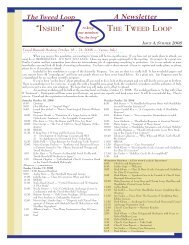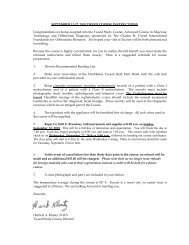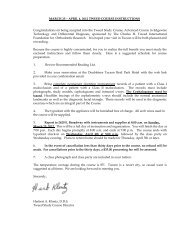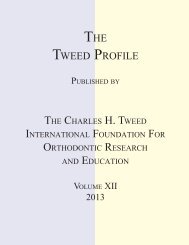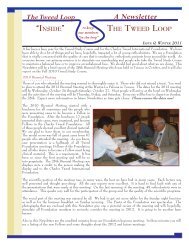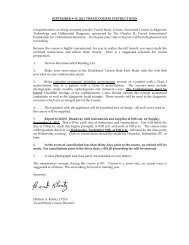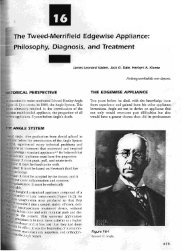© 2006 - The Charles H. Tweed International Foundation
© 2006 - The Charles H. Tweed International Foundation
© 2006 - The Charles H. Tweed International Foundation
You also want an ePaper? Increase the reach of your titles
YUMPU automatically turns print PDFs into web optimized ePapers that Google loves.
Fig. 11. Intrusion and Torque Control of Incisors; MIwas installed between 2 central incisors and appliedintrusive force using elastic thread.for the technique can be used. To intrude upperincisors, the micro-implant can be installed in theinterdental space between the two central incisors.Fig. 12. Correction of open bite: Intrusion of molars using microimplants.Consider the anatomy of the interseptal bone and CR of the denitition for selection of the implant site. In typical patients,the height of placement should be around 8-10 mm from the arch wire. However, the vertical height of an MI can bedetermined by the force direction to be used.IV - 2 Choice of implantsSeveral sizes of MIs with diameters from 1.2 mm to 1.8 mm for different tasks and sites have been developed.Generally, a bigger diameter can withstand greater force. However, the diameter of 1.3 mm can withstand up to 450 gmof orthodontic force. Most orthodontic force is less than 300 grams. <strong>The</strong> tapered type seems to offer more “tightness”initially than does the cylinder type.So, the first choice for an MI is the diameter of 1.3 to 1.5 mm tapered type. However, the diameter of 1.5-1.7 mm can beused when there is enough space between the roots and greater force is needed. When intermaxillary elastics are used, weprefer to use the 1.5 mm diameter and circle type head because it is easier to wear elastics and is strong.V. Success and failure.<strong>The</strong> failure of an orthodontic microimplant means that the microimplant becomes loose during treatment. This usuallyhappens within the first three months following placement. If mechanical stability is not achieved immediately afterplacement, do not expect the microimplant to be stable. Initial mechanical stability is important, therefore, to the successof microimplant anchorage. In our experience, the microimplant almost always fails if it touches a root during placement.Thus, to prevent a microimplant from contacting the roots of adjacent teeth, the morphology of the roots and of theinterradicular space in which the microimplant is to be placed must be understood. In addition, the location, path andinsertion area of the microimplant, as well as the size of the microimplant, must be considered. At this point in time, wecannot achieve a 100% success rate when we use MI for temporary orthodontic anchorage. However, MI does have ahigh success rate of approximately 90%, a rate that is similar to that of miniplates and large titanium screws. A MI canbe used as temporary anchorage immediately after placement for any type of orthodontic tooth movement.SummaryWe are convinced that this anchorage technique is a powerful tool for significantly changing the orthodonticparadigm, although we need more study and experience.40



